“The Slaver Weapon”
Written by Larry Niven
Directed by Hal Sutherland
Animated Season 1, Episode 14
Production episode 22011
Original air date: December 15, 1973
Stardate: 4187.3
Captain’s log. Spock, Sulu, and Uhura are on the shuttlecraft Copernicus, delivering a Slaver stasis box that was recently discovered by Kzinti archaeologists to Starbase 25. Whatever is inside the stasis box has been perfectly preserved for as long as it’s been in existence—and the Slavers conquered the entire galaxy billions of years earlier, and when they were wiped out, life had to evolve in the galaxy from scratch. The stasis boxes that have been found are the only source of information they have about that long-ago time.
The stasis box starts to glow, which indicates that there’s another stasis box in the nearby star system of Beta Lyrae. Spock orders Sulu to change course to the system, since the only thing that detects a stasis box is another stasis box.
The Copernicus lands on an icy planet. Just as the landing party detects the location of the stasis box, they are ambushed by a party of Kzinti and taken prisoner.

The Kzinti are only willing to deal directly with Sulu, as Spock is a vegetarian, for whom the Kzinti have no respect, and Uhura is a woman. Kzinti females are little more than dumb animals, and Spock instructs Uhura to play to that notion, so her being unnoticed might be turned to their advantage.
They’re interrogated by Chuft Captain, who commands this stolen police vessel, Traitor’s Claw. They’re privateers—or, at least, they claim to be. In truth, they’re covert operatives for the Kzinti government, trying to find weapons they can use to fight another war against the Federation. The stasis box on this world was empty, but they used it as a lure to draw the Copernicus there so they could get their hands on the box in their possession.
Chuft Captain opens the box, which contains a picture of a Slaver, a piece of raw meat, and a weapon of some sort. The meat turns out to be poisonous, but the weapon has several settings that change the shape of the object. At least one setting is a telescope, another is a laser, and another is a rocket that sends Chuft Captain careening about the landscape. Uhura is able to escape the web that has the landing party trapped, but the Kzinti gun her down.

Another setting is an energy absorber, though somehow it doesn’t affect their life-support belts. It does deactivate the web they’re trapped in, however, and the trio make a run for it, going off in all directions. Spock attacks Chuft Captain and takes the weapon. But Uhura is, once again, gunned down.
Now Chuft Captain has Uhura as a hostage, but Spock has the weapon. Spock also dishonored Chuft Captain—he’s a plant eater, and he attacked Chuft Captain and didn’t kill him. That’s a shame that will keep him from calling for reinforcements.
Chuft Captain offers Spock combat—basically a rematch—but they refuse. Sulu and Spock continue to test the weapon, and they find a setting that causes such severe damage as to affect the weather. The subsequent windstorm knocks them unconscious and allows them to be captured again.
The Kzinti finds another setting which allows an AI within the weapon to communicate with them. The computer voice asks for several codewords, which of course, the Kzinti don’t know. When Chuft Captain asks for the high-energy beam setting that Sulu used earlier, the computer provides a setting which changes to a configuration that is not the same as what Sulu found earlier. Spock deduces that the weapon believes it has fallen into enemy hands and has gone to the self-destruct setting. Sure enough, when Chuft Captain tests it, it blows up, killing all the Kzinti. Inside the police web, the landing party is protected.
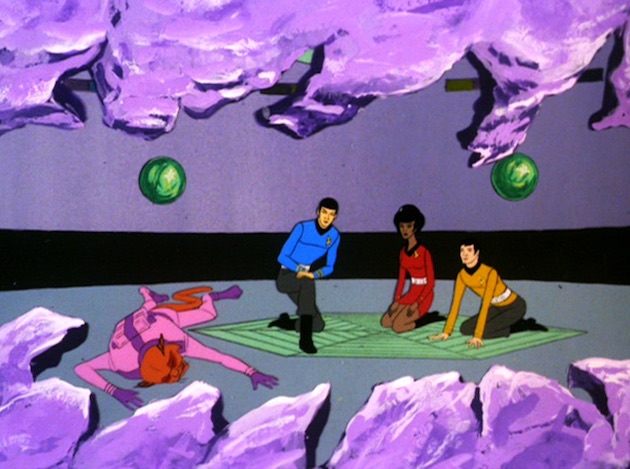
They re-board the Copernicus and head back on course, since they still have two (now empty) stasis boxes and a picture of a Slaver to deliver to Starbase 25.
Can’t we just reverse the polarity? One stasis box that was found in the past had a flying belt that was the basis of artificial gravity technology. Another had a bomb in it that went off as soon as the box was opened—because of that, Starfleet automatically gets jurisdiction of all stasis boxes that are found, and they can only be opened by specialists.
Fascinating. Spock uses the Kzinti cultural prejudices against them, in particular making sure to attack Chuft Captain and leave him alive to shame him, thus keeping him from calling in reinforcements.
Ahead warp one, aye. Sulu speaks for the landing party to the Kzinti, as they won’t talk to an herbivore or a woman. He figures out that the crew of Traitor’s Claw are truly government operatives posing as privateers who can be disavowed. He also theorizes that the weapon is one of spycraft rather than that of a soldier, and his logic actually impresses Spock.
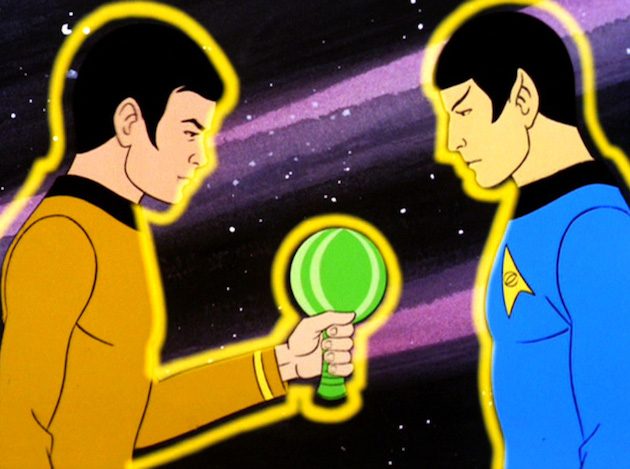
Hailing frequencies open. Uhura is not thrilled at the notion of having to pretend to be stupid. Then again, she also tries to escape twice and both times get shot and recaptured…
Channel open.
“They think very little of you.”
“Wrong. They don’t think much of you.”
–Chuft Captain’s reaction to Spock refusing a rematch, and Uhura setting him straight.
Welcome aboard. James Doohan does the voices of some of the various Kzinti—he’s definitely Chuft Captain and his second, and he might be the telepath. Majel Barrett is the voice of the slaver weapon’s computer, and George Takei and Nichelle Nichols are the voices of Sulu and Uhura.
Trivial matters: Larry Niven adapted his short story “The Soft Weapon” into this episode, which is part of his “Known Space” oeuvre, including the popular Man-Kzin Wars anthology series. D.C. Fontana and Gene Roddenberry specifically recruited him to write an episode for the animated series, encouraged by them to adapt one of his “Known Space” short stories.
This is the first Star Trek screen story since the introduction of the character that does not feature Kirk. The next one will be “Encounter at Farpoint,” the premiere of TNG in 1987.
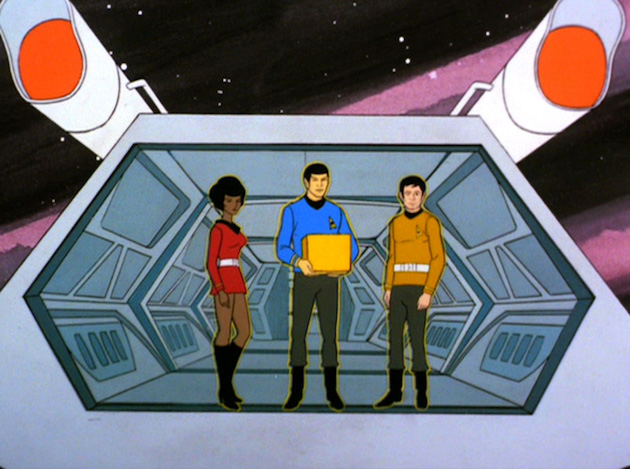
Vulcans being vegetarians was established in “All Our Yesterdays,” thus making Spock an amusing analogue for Nessus, the character in the story who is also a pacifist and an herbivore, though Nessus is manic-depressive and insane.
Sulu’s affinity for weapons was established in “Shore Leave” when he geeked out over an old pistol.
This is the only appearance of the Kzinti in the Star Trek universe on screen, and they’re never mentioned again (though they were mentioned in “The Infinite Vulcan” and seen in “The Time Trap” prior to this), mostly to avoid copyright issues. The Kzinti do appear in the game Star Fleet Battles (that game’s odd partial license included the animated series, although the Kzinti in the game vary from the Kzinti of this episode in some aspects), and also appeared in a run of the Star Trek comic strip that was co-authored by Niven and Sharman DiVono in 1982. Niven did open the Kzinti to other authors in his Man-Kzin Wars anthologies, of which there have been fourteen as of this writing.
The main difference between how the Kzinti are described in Niven’s prose and how they’re portrayed visually here is the lack of stripes, as apparently stripes would be too expensive to animate, and so they are monochrome.
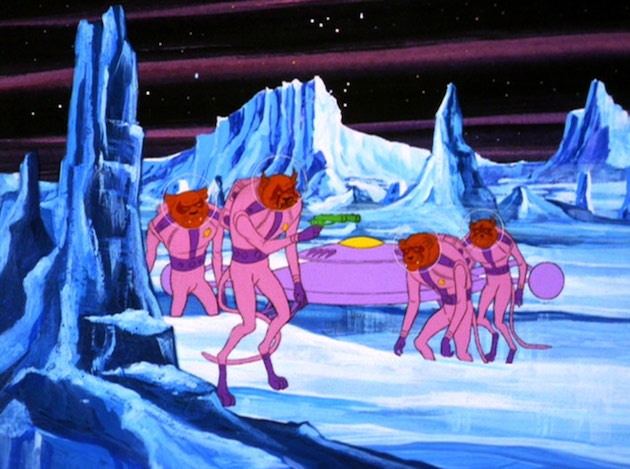
To boldly go. “He makes me taste yellow root munched between flat teeth!” I absolutely adore this episode, and consider it to be one of the finest Trek episodes extant. Part of that is because it keeps things simple, just the three people on the shuttlecraft—and those three are not Kirk, Spock, and McCoy. What’s more, Larry Niven does an excellent job of making use of what we already know about Spock (that he’s a pacifist and a vegetarian) and Sulu (he’s a weapons collector).
And in the Kzinti we have a fascinating alien culture with cultural mores that are a sensible extrapolation of a feline species. I particularly like the telepath who is revolted by the images he receives of eating plants in Sulu and Spock’s heads.
On top of that, we have the Slavers and the stasis boxes, both nifty science fictional concepts.
I could live without the sexism—one thing that is not a sensible extrapolation of a feline species is the notion of women as dumb animals, plus Uhura is basically useless in the episode—and in truth the telepath doesn’t actually serve much of a plot function. And there’s a bit too much of our heroes being captured, freed, and captured again.

But I like the intelligent conversations among the landing party about history and archaeology and the doping out of the weapon. I like the way Spock tries to play the Kzinti, and only partially succeeds (for starters, Chuft Captain knows that Uhura is intelligent, and so Spock’s hope that they won’t notice her turns out to be a forlorn one). And I like the fact that this story actually works perfectly in the half-hour format. Too many of the animated episodes either have too little or too much story for the running time, but this one is just right.
Once again, Star Trek proves that hiring science fiction authors to write science fiction stories will give you quality work—viz., “The City on the Edge of Forever,” “Amok Time,” “The Doomsday Machine,” and this.
Warp factor rating: 9
Next week: “The Eye of the Beholder”
Keith R.A. DeCandido will be a guest at the first-ever HELIOsphere convention in Tarrytown, New York this weekend, alongside guests of honor David Gerrold, Jacqueline Carey, and Danielle Ackley-McPhail, among many others. Saturday will be the launch party for Baker Street Irregulars, the alternate Sherlock Holmes anthology that Keith has a story in; fellow contributors Gerrold, Austin Farmer, and Hildy Silverman, and co-editor Michael A. Ventrella will also be there. Keith’s full schedule can be found here.










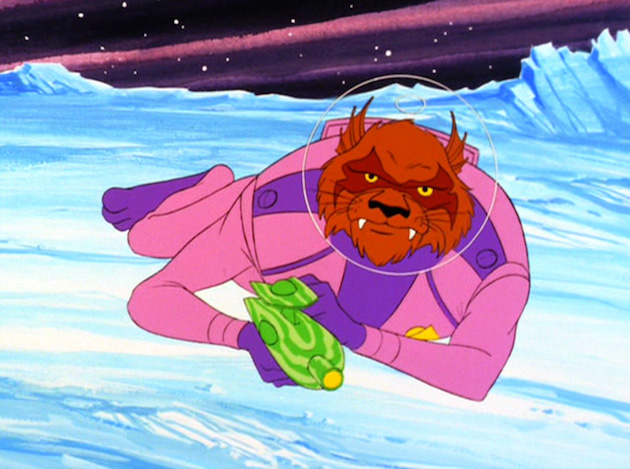
Is there a Kzin on the Elysian Council during The Time Trap? If you look at the picture, he’s right between the Klingon and the Andorian.
http://www.tor.com/2017/02/21/star-trek-the-original-series-rewatch-the-time-trap/
I love this episode, but I’m biased because I’m a big Niven fan.
I agree that the story fits the half-hour format perfectly. I also enjoyed that it’s another episode about a shuttlecraft crew after The Galileo Seven and Metamorphosis, this time without involving the Enterprise at all. (Come to think of it, the Enterprise scenes in Metamorphosis didn’t really add anything to the story.) And as much as I like Kirk and McCoy, it’s nice to have a story about Uhura and Sulu for a change.
Still, I must admit that I didn’t like it much. For one thing, it feels like a sales event. “Look at our amazing multifunctional weapon! There’s this setting… and this… and this… and in this setting, it cooks coffee and casts your horoscope!” And then in the thrilling climax, the fearsome galactic conquerors push the wrong button. Our guys don’t win the day because they’re smart or because they’re kind but because their antagonists are stupid. It’s also a rather nasty ending, and Spock et al. don’t seem to be even remotely sorry for the Kzinti.
Uhura is pretty snarky in this episode. I’m not sure if this is in character for her. She did make fun of Spock and Charlie in Charlie X, and her “Sorry, neither” in The Naked Time was also quite witty, but the tone was different.
On a side note, Vulcan vegetarianism is already implied in The City on the Edge of Forever when Kirk buys “assorted vegetables” for Spock and sausage for himself.
The Kzinti may not have appeared in any other Trek movies or books, but they were (and possibly still are?) included in the Trek board game Star Fleet Battles and its various subsequent incarnations.
According to Memory Alpha, Niven originally pitched a story that he would eventually turn into “The Borderland of Sol”, but with Outsiders being the ones taking the ships. I guess that makes Kirk Bey Schaeffer and Spock Carlos Wu. The producers thought it was too science heavy and not suitable for Saturday morning. Roddenberry suggested an adaptation of “The Soft Weapon”.
I think the Kzinti also appear in Starfleet Battles. It’s not canonical and it’s been decades since I played it, but I seem to remember them there.
Imagine poor Alan Dean Foster having to write the adaptation of this episode. How do you not wind up cribbing from the original story, even if only unconsciously?
One of the best of TAS, right up there with Yesteryear. Good pacing, characterization. Nifty aliens that actually think and act in an alien manner. And no Kirk to be seen. Nothing against the captain but it’s nice to see that his crew can actually be the heroes without him. However, Uhura does get the short end of the stick. She does get some good shots in at the Kzinti but really, captured twice? And after bragging how well she used to run. (And why do Sulu and Spock get nifty, action running poses and Uhura looks like she’s simply walking quickly?).
The Kzinti are a great addition to the Trek universe and it’s a shame we didn’t get to see them again. R|umours are that they might have shown up on Enterprise it it had gotten one more season. Would have been cool to see them there.
9/10
5. DemetriosX – ADF wrote a framing story, changing the origins of the first box so it was found on a different planet and Spcok, Sulu and Uhura have to recover it. Meanwhile, the Enterprise is on it’s way to an important briefing at a nearby starbase but they also run into problems. The second half of the book is a new story that ties in with the stories in the beginning of the book. As usual, ADF does a great job fleshing out the 22 minutes cartoons.
The Kzin were definitely in Starfleet Battles. I should know since I wrote one of the Battle Forces for them in Captain’s Log 12 (my sole writing credit of any kind). IIRC, there were a couple of passing references to the Kzin in the novels, but no story or major plot point devoted to them.
This is a weird one. Usually, when a writer adapts an existing story to a new series, they change the story to fit the series — see, for instance, TNG’s “Tin Man,” loosely adapted by its authors from their original SF novel Tin Woodman, with the whole backstory and characters radically changed and names reassigned. But Niven did the opposite — he changed the parameters of the series to fit the existing story. “The Slaver Weapon” is not so much a Star Trek episode as a dramatization of “The Soft Weapon” with three Trek characters acting out the roles of Nessus and Jason and Anne-Marie Papandreou. It follows the plot of the original novelette almost verbatim, with only a bit of streamlining. The stasis box was found on Kzin rather than bought from the Outsiders. The weapon is attributed to the Slavers rather than the Tnuctipun slaves who led the revolt against them (a far more logical origin for a spy weapon). And the number of items in the box and the number of settings on the weapon are reduced a bit. Otherwise, it’s the exact same story.
And adapting it to the Trek milieu creates a number of problems. For one thing, saying the box originated on Kzin is bizarre, because it means that Chuft-Captain has a legitimate claim to the box. It’s his people’s property by right, and Starfleet basically committed artifact theft by taking it from them. I find that troubling. (Maybe that’s why Alan Dean Foster gave it a different origin, an archaeological dig on Gruyakin Six.) For another, there’s the aforementioned contradiction of the power absorber not affecting the life support belts (the original characters had spacesuits). Relatedly, Sulu recognizes the “police web” as a familiar device, but we’ve never seen the technology in the Trek universe before or since. And while it’s a clever idea to plug Spock into the Nessus role, the dialogue doesn’t quite fit Spock. One, Vulcans aren’t herbivores (i.e. evolutionarily adapted to eating only plants), but omnivores who choose a vegetarian lifestyle. It’s not quite the same. Two, Spock is not a pacifist. He couldn’t be a Starfleet officer if he were, so it wouldn’t make sense for the Kzinti to see him as one. And because we’ve seen Spock fight many times before, the moment where he kicks Chuft-Captain isn’t remotely as startling a moment as when Nessus does it in the original.
Also, the episode doesn’t fit the Trek continuity retroactively, because later productions disregarded it. There’s no way to fit four Man-Kzin Wars into modern Trek history prior to 2070. (The original story was set in the 27th century or so.)
I also don’t think it makes a particularly good Trek story on its own merits, particularly not a TAS story. It doesn’t really have anything to say — no thematic or philosophical subtext. It’s just a problem-solving exercise and a battle of wits against an enemy. It’s unique in TAS and rare in Filmation’s ouevre in that it ends with the villains being killed outright rather than reasoned with or outwitted. Despite being fairly action-heavy, it’s incredibly talky; the first act is largely one long monologue by Spock to fill in the backstory, which I find a rather clumsy way to write a TV script. It also has a really weak and awkward ending. Even aside from the questionable taste of laughing about the deaths of one’s enemies, that last exchange about Kzinti superstitions isn’t even funny. In my past viewings, I’ve been so concerned about comparing it to “The Soft Weapon” and contemplating its continuity issues relative to Trek that I haven’t really thought about it as an episode per se, and I realize it’s got more problems in that regard than I thought.
It’s also got a lot of animation errors, like the configuration of the weapon being inconsistent from shot to shot, and the force-field outlines not matching the characters. Also the initial shots of Beta Lyrae through the shuttle window are totally wrong, looking more like a spiral galaxy, although the subsequent shot as the shuttle flies past it is fairly accurate. It also annoys me that Filmation used their stock “run like a girl” animation cycle for Uhura (I remember seeing the same run cycle in other shows of theirs, e.g. for Ginger and Mary Ann in The New Adventures of Gilligan), which isn’t very consistent with her claim of being a record-setting sprinter.
It is nice to get a Sulu-centric episode, and one that gives Uhura a fair amount to do, even if she’s mostly relegated to damsel in distress. It’s also neat that the episode has no Caucasian characters in it at all (technically, since Spock is half-Vulcan and has greenish-yellow skin).
Voice-wise, the Kzin who reports on the meat being poisonous sounds like Lou Scheimer, though I’m not certain. All the others seem to be Doohan, and the weapon computer is apparently Barrett.
Alan Dean Foster’s adaptation of the episode is pretty unusual too. The last four of his Star Trek Logs adapted one episode each followed by an original sequel story making up roughly the last 2/3, but Log Ten goes even farther. Only 3 of its 16 chapters adapt the episode, and it includes three new stories framing the adaptation — the story of how the threesome came into possession of the stasis box before the episode; a plot about what was going on back on the Enterprise during the episode (which was basically about M’Ress going into heat/pon farr); and a followup plot in which Kirk, Spock, Sulu, and Uhura got their minds swapped in a transporter accident.
With thanks to David Weingart, hoopmanjh, and Charles Rosenberg here, and Allyn Gibson on Facebook, I’ve adjusted the Trivial Matter that discusses the lack of Kzinti in the rest of the Trek universe to address their appearances in Star Fleet Battles and also in a run of the Trek comic strip co-written by Larry Niven in 1982.
—Keith R.A. DeCandido
@3: You basically just described the plot of Arsenal of Freedom :)
I did like this episode, but it was weird seeing this shoehorned into the ST continuity.